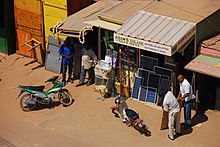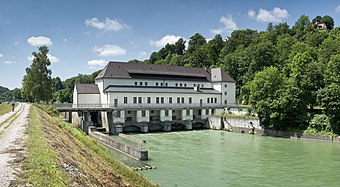
Back بوابة:طاقة متجددة Arabic Portail:Énergie renouvelable French Portal:Tenaga boleh diperbaharui Malay Portal:可再生能源 Chinese
Introduction Renewable energy (or green energy) is energy from renewable natural resources that are replenished on a human timescale. Using renewable energy technologies helps with climate change mitigation, energy security, and also has some economic benefits. Commonly used renewable energy types include solar energy, wind power, hydropower, bioenergy and geothermal power. Renewable energy installations can be large or small. They are suited for urban as well as rural areas. Renewable energy is often deployed together with further electrification. This has several benefits: electricity can move heat and vehicles efficiently, and is clean at the point of consumption. Variable renewable energy sources are those that have a fluctuating nature, such as wind power and solar power. In contrast, controllable renewable energy sources include dammed hydroelectricity, bioenergy, or geothermal power. Renewable energy systems are rapidly becoming more efficient and cheaper. As a result, their share of global energy consumption is increasing. A large majority of worldwide newly installed electricity capacity is now renewable. In most countries, photovoltaic solar or onshore wind are the cheapest new-build electricity. Renewable energy can help reduce energy poverty in rural and remote areas of developing countries, where lack of energy access is often hindering economic development. Renewable energy resources exist all over the world. This is in contrast to fossil fuels resources which are concentrated in a limited number of countries. There are also other renewable energy technologies that are still under development, for example enhanced geothermal systems, concentrated solar power, cellulosic ethanol, and marine energy. From 2011 to 2021, renewable energy grew from 20% to 28% of global electricity supply. Use of fossil energy shrank from 68% to 62%, and nuclear from 12% to 10%. The share of hydropower decreased from 16% to 15% while power from sun and wind increased from 2% to 10%. Biomass and geothermal energy grew from 2% to 3%. In 2022, renewables accounted for 30% of global electricity generation, up from 21% in 1985, and projected to reach over 42% by 2028. Many countries around the world already have renewable energy contributing more than 20% of their total energy supply. Some countries generate over half their electricity from renewables. A few countries generate all their electricity from renewable energy. National renewable energy markets are projected to continue to grow strongly in the 2020s and beyond. The deployment of renewable energy is being hindered by massive fossil fuel subsidies. In 2022 the International Energy Agency (IEA) requested all countries to reduce their policy, regulatory, permitting and financing obstacles for renewables. This would increase the chances of the world reaching net zero carbon emissions by 2050. According to the IEA, to achieve net zero emissions by 2050, 90% of global electricity generation will need to be produced from renewable sources. Whether nuclear power is renewable energy or not is still controversial. There are also debates around geopolitics, the metal and mineral extraction needed for solar panels and batteries, possible installations in conservation areas and the need to recycle solar panels. Although most renewable energy sources are sustainable, some are not. For example, some biomass sources are unsustainable at current rates of exploitation. (Full article...) Selected article - Renewable energy in developing countries is an increasingly used alternative to fossil fuel energy, as these countries scale up their energy supplies and address energy poverty. Renewable energy technology was once seen as unaffordable for developing countries. However, since 2015, investment in non-hydro renewable energy has been higher in developing countries than in developed countries, and comprised 54% of global renewable energy investment in 2019. The International Energy Agency forecasts that renewable energy will provide the majority of energy supply growth through 2030 in Africa and Central and South America, and 42% of supply growth in China. Most developing countries have abundant renewable energy resources, including solar energy, wind power, geothermal energy, and biomass, as well as the ability to manufacture the relatively labor-intensive systems that harness these. By developing such energy sources developing countries can reduce their dependence on oil and natural gas, creating energy portfolios that are less vulnerable to price rises. In many circumstances, these investments can be less expensive than fossil fuel energy systems. In isolated rural areas, electricity grid extensions are often not economical. Off‐grid renewable technologies provide a sustainable and cost‐effective alternative to the diesel generators that would be otherwise be deployed in such areas. Renewable technologies can also help to displace other unsustainable energy sources such as kerosene lamps and traditional biomass. (Full article...)Quotations -
– International Energy Agency, Renewable energy... into the mainstream, 2002. Main topicsRenewable energy sourcesGeneralRenewable energy commercialization · Smart grid · Timeline of sustainable energy research 2020–present Renewable energy by countryList of countries by electricity production from renewable sources
WikiProjectsWikiProjects connected with renewable energy: Selected image -Selected biography -Steven Chu FREng ForMemRS HonFInstP (born February 28, 1948) is an American physicist and former government official. He is a Nobel laureate and was the 12th U.S. secretary of energy. He is currently the William R. Kenan Jr. Professor of Physics and Professor of Molecular and Cellular Physiology at Stanford University. He is known for his research at the University of California, Berkeley, and his research at Bell Laboratories and Stanford University regarding the cooling and trapping of atoms with laser light, for which he shared the 1997 Nobel Prize in Physics with Claude Cohen-Tannoudji and William Daniel Phillips.[ambiguous] Chu served as U.S. Secretary of Energy under the administration of President Barack Obama from 2009 to 2013. At the time of his appointment as Energy Secretary, Chu was a professor of physics and molecular and cellular biology at the University of California, Berkeley, and the director of the Lawrence Berkeley National Laboratory, where his research was concerned primarily with the study of biological systems at the single molecule level. Chu resigned as energy secretary on April 22, 2013. He returned to Stanford as Professor of Physics and Professor of Molecular & Cellular Physiology. (Full article...)Did you know? -... that REN21, the Renewable Energy Policy Network for the 21st Century, is a policy network that provides a forum for international leadership in renewable energy policy, in order to share knowledge and facilitate the rapid growth of renewable energy technologies in developing countries and industrialised economies ? The network launched in June 2005, operates from offices in Paris, France, and is provided by the United Nations Environment Programme and the Deutsche Gesellschaft für International Zusammenarbeit in collaboration with the International Energy Agency. Since 2005 REN21 has produced an annual Renewables Global Status Report, with Eric Martinot and Janet Sawin as lead authors. General images -The following are images from various renewable energy-related articles on Wikipedia.
Related portalsCategoriesAssociated WikimediaThe following Wikimedia Foundation sister projects provide more on this subject:
Discover Wikipedia using portals |
© MMXXIII Rich X Search. We shall prevail. All rights reserved. Rich X Search


















![Image 13Concentrated solar panels are getting a power boost. Pacific Northwest National Laboratory (PNNL) will be testing a new concentrated solar power system – one that can help natural gas power plants reduce their fuel usage by up to 20 percent.[needs update] (from Solar energy)](http://upload.wikimedia.org/wikipedia/commons/thumb/8/82/Photo_of_the_Week-_Boosting_Solar_Technology_%288722948189%29.jpg/120px-Photo_of_the_Week-_Boosting_Solar_Technology_%288722948189%29.jpg)






























































